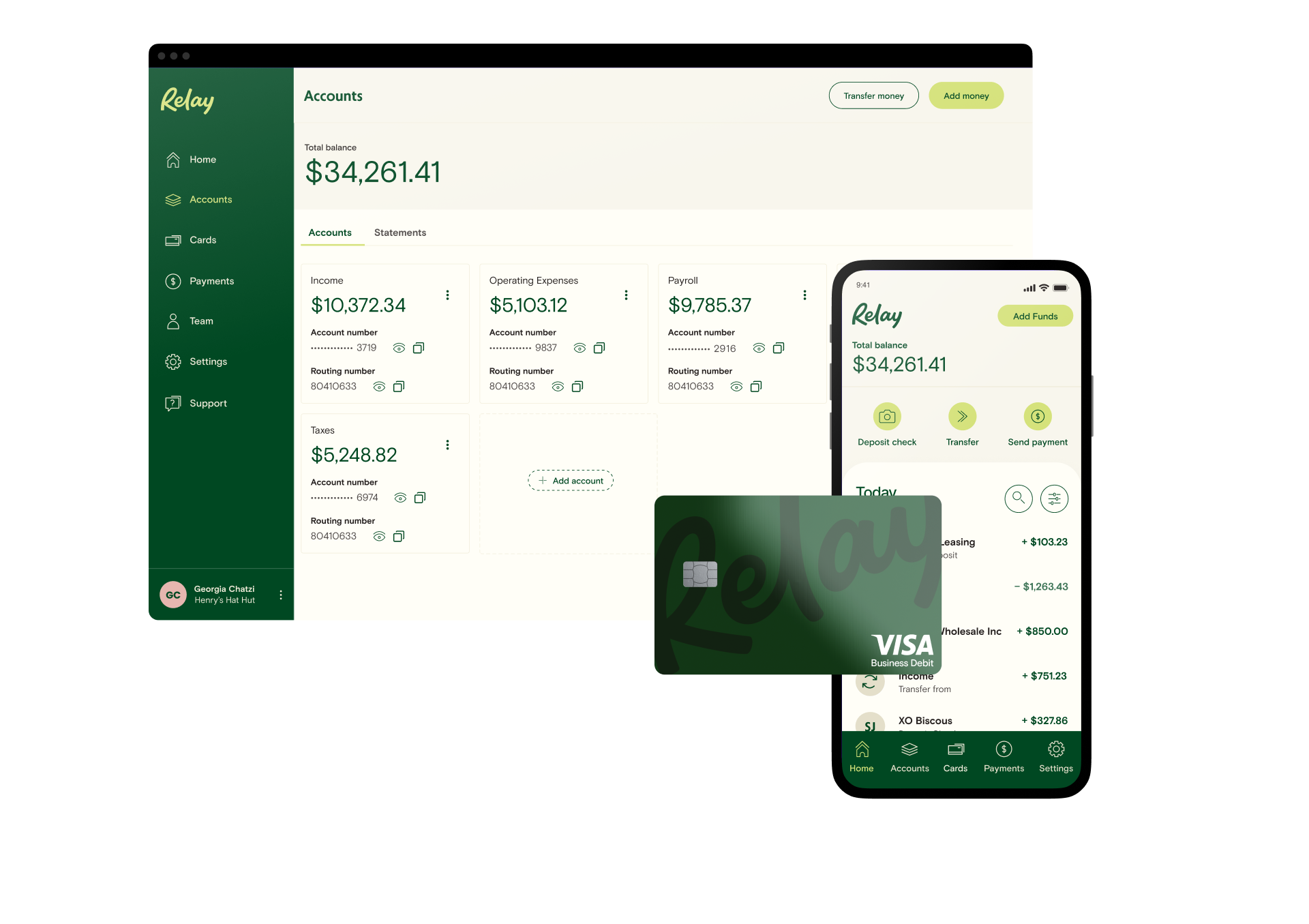Most small business owners struggle with cash flow management, whether it’s clients paying late, unexpected expenses, or seasonal fluctuations. Unfortunately, this can lead to late debt payments, payroll problems, and lots of unnecessary stress. 😬 In this guide, we’ll give you the strategies you need to master cash flow management 💸 and get your business’s financial health on track.
Cash flow management shouldn’t be complicated. Yet, not knowing where you stand financially (on top of a dozen other factors) can put your business in a risky spot. In fact, that’s exactly why we built Relay, a business banking and money management platform designed to give you total transparency around how much you're earning, spending, and saving.
If you’ve ever found yourself scrambling to keep up with payments and expenses, you're not alone. According to a study by Wave, most business owners have less than $5,000 in free cash flow available — that’s the cash balance on hand for emergencies and investments after all your bills are paid.
So where do you start when it comes to cash flow management? Whether you’re a new business owner or a seasoned professional, we’re here with the step-by-step guide to mastering your cash flow, so you can pay expenses, grow your business, and ditch the stress.
In this article:
What is cash flow management? 💵
Cash flow management is the process of monitoring, analyzing, and controlling the inflow and outflow of cash in a company. When this process is going well, your business should have positive cash flow 📈 — more cash coming in than going out. If the business is struggling, however, you may find yourself with more cash going out than coming in (AKA, negative cash flow 📉).
Cash flow management includes the following activities:
Making sure that the company has enough cash to pay for operating expenses and business needs, including payroll, rent, insurance, software, etc. 📋
Staying on top of expenses so that they don’t outgrow the business’s revenue or reduce its profit margin by too much 💰
Forecasting and budgeting for future cash needs and capital expenditures, like purchasing a new office space 🏢
Ensuring the business has positive working capital (current assets minus current liabilities) so that it can take advantage of new opportunities and invest in growth 🌳
Cash flow vs. profit 🤔
But how does cash flow differ from profit?
Basically, profit is a measure of a company's financial performance. It's the amount of money a company earns after all expenses have been taken into account. A company can have a positive profit 📈 (earning more money than it spends) or a negative profit 📉 (spending more money than it earns).
On the other hand, cash flow simply refers to the amount of cash coming into and going out of a business. 💸 It’s crucial to day-to-day operations — even if a company is making a profit, it will struggle to pay expenses if that cash isn’t flowing on a consistent schedule. As a result, cash flow is also closely tied to the business’s success.
Why is effective cash flow management so important?
When it comes to your business finances, it’s easy to focus on revenue and profit. However, as one wise Reddit user wrote, “Revenue is vanity, profit is sanity, cash flow is reality.” 💵
Let’s say your business has a 30% profit margin. This is great news 🎉— except for the fact that your clients always pay late and you’re constantly asking your lenders for an extension on your loan payments.
That’s why cash flow management is so crucial: cash is the number one factor in your ability to keep your business healthy, stable, and growing. Without it, you might lose talented employees who are tired of payroll problems or find yourself burnt out every month as you juggle expenses.
Here are 3 more reasons why every business owner should improve their cash flow management skills. 🙌
1. To be ready in an emergency 🚨
If you’re an entrepreneur, you know that the unexpected is just part of life. Whether you lose a client or seasonal fluctuations lead to a sudden decrease in sales, your ability to respond quickly is crucial to the business’s long-term survival. Cash flow management helps you consistently set aside extra cash so that you can stay flexible and be prepared for these types of emergencies. 👏
2. To protect your credit rating 💳
Without proper cash flow management, a business may struggle to pay its bills on time, resulting in late fees, penalties, and damage to its credit rating. 😬And a poor credit rating means that if the business needs to rely on credit for an emergency or to make an investment, it could face higher interest rates or a lack of access to capital at all.
3. To take advantage of opportunities for growth 📈
If your business doesn’t have extra cash on hand, you may miss out on opportunities for expansion. Whether it’s a great deal on real estate or an exciting new certification for your team, cash is the key to being prepared to grow the business. 💰
What causes cash flow problems? 😬
Before we discuss how to improve poor cash flow management, we need to understand what causes cash flow issues in the first place. Here are some of the most common causes:
Late payments: When customers don't pay their bills on time, it can create a cash flow crunch for the business. 😒
High inventory levels: Having a lot of inventory on hand can tie up cash that could be used to pay bills or invest in growth.
High fixed costs: High fixed costs, such as rent or salaries, can put a strain on cash flow if sales are slow. 🐌
Seasonal fluctuations: Many businesses experience fluctuations in sales throughout the year, which can create problems if the business has a shortfall of cash on hand to cover expenses during slow periods.
Not having a cash flow forecast: Not understanding the business’s expected future cash flow can cause you to be unaware of upcoming cash shortages. 🫣
To maintain a positive cash flow, business owners need to take steps to manage and mitigate these problems. The good news is that there are more than a few strategies you can begin utilizing today to become a cash flow master. 🤑
Cash flow management made simple: 5 steps
Effective cash flow management is about having a clear understanding of your business's cash inflows and outflows, being able to predict and adjust to fluctuations, and having the right systems and processes in place to manage it effectively.
These five cash flow management strategies will help you stay on the money and boost your business’s financial health. Let’s dive in.
1. Make tracking cash flow a habit 🧐
The most important strategy for cash flow management is to simply keep a close eye on how much money is coming in and going out of your business. This will help you identify any patterns or issues that might be impacting your cash flow, allowing you to take action to resolve those problems right away. 👊
One of the best ways to manage cash flow is by using an online banking platform like Relay. With Relay, you can get ultra-detailed information 🔎 on all of your transactions and sync that data directly to your accounting software. Whether it’s just you or you’re managing a team, you won’t have to waste any more time decoding your transaction data.
Reviewing your cash flow statement can also help you stay on top of cash flow. Using information from financial statements like your accounts receivable and accounts payable, this report gives you an overview of cash flow over a specific period of time. It can be created by your accountant or generated from your bookkeeping software.
Ultimately, understanding your spending and reviewing your cash flow statement is key for making informed decisions about how much cash to keep on hand, how to prioritize payments, and how to plan for future expenses. ✅
2. Create (and stick to) a budget 📝
Did you know that 82% of businesses fail due to poor cash management? 😬 That’s why a budget is essential for any business that wants to be around for the long term.
Think of your budget as your plan for cash flow management, containing your monthly and annual bills, cash flow projections, and a buffer for unexpected expenses. This plan will help you feel confident in your ability to meet all your financial goals and obligations.
Just remember to review and update your budget regularly to ensure that it is aligned with changes in the business’s operations, as well as seasonality and your sales cycle. 🔄 Reviewing things on a weekly and monthly basis is a good idea to ensure you stay on track with cash flow management.
3. Use automation to your advantage 💻
When it comes to cash flow management, automation is crucial. From making sure your clients pay on time to seamlessly transferring funds to your savings account, there are plenty of tools available to simplify your life.
One of the first things to consider automating is customer payments. 💵 If customers are on any sort of subscription or payment plan, try using incentives to encourage them to set up autopay. Late payments can have a big impact on your company’s cash flow, but autopay also helps streamline your customers’ lives — no more manually entering credit information each month.
If customers do miss a due date, it’s a good idea to have a system for following up on late payments. Two essential pieces of that system will be automatically sending reminder emails and applying late fees according to your company’s payment terms.
You can also utilize automation for cash flow management with Relay. Our online money management platform allows you to set up automatic, percentage-based transfers between accounts. That will make it easier for you to manage cash as it comes in, whether you’re moving it to a profit account or using a digital envelope budgeting system.
4. Keep an eye on your expenses 💰
If your revenue suddenly increases, it can be easy to take on new expenses without fully understanding the impact. That’s where cash flow analysis comes in — responsible financial management requires business owners to both reduce unnecessary expenses and make smart decisions about new expenses. 💵
If your sales go up, take a step back and look at your company’s historical data. Is this just a seasonal lift? Or is this actual growth? If all signs point to the latter, then it might be okay to increase your expenses in order to address the new demand. The most important thing here is just to continue to pay attention to your cash flow and make informed decisions about any new spending. 💡
5. Have a backup plan 🛟
Sometimes, cash flow problems are out of your control. Whether it’s a global pandemic or personal problems keeping you away from work, there may come a time when you need a short-term plan to handle a lack of cash flow. 📝
Being able to adjust to sudden changes is an important part of effective cash flow management. Your preparation can include having an emergency fund to cover unexpected expenses or being able to quickly scale back or increase expenses depending on the situation.
You may also want to apply for a business credit card or request a line of credit from your financial institution. 🏦 Remember: the best time to prepare for problems is when your cash flow is healthy — not when it’s struggling.
How Profit First can improve cash flow management 🙌
Profit First is a cash management methodology that prioritizes profit and helps businesses optimize cash flow. 💸 The basic idea is that by setting aside a percentage of income for profit first, before paying bills, businesses can ensure that they have enough cash on hand to manage expenses and invest in growth.
Whether you’re working on debt repayment or trying to increase your profit margin, the Profit First method can keep you incredibly focused. Instead of spending blindly, it instructs business owners to set aside revenue for different financial goals as soon as it lands in their accounts.
Here's how it works:
Set up multiple bank accounts: The first step is to set up individual bank accounts for different types of expenses, such as operating expenses, taxes, and profit. This makes it easy to see where your business is at with each of its goals.
Prioritize profit: Next, set aside a percentage of income for profit first, before paying your bills. This ensures that you’re earning enough to “pay yourself first” — even if it’s just 5% of your revenue.
Allocate income and expenses: The third step is to allocate the rest of your revenue to the appropriate accounts and ensure expenses are coming out of the right accounts. This will help you keep expenses under control and stay on budget.
Track and adjust: The final step is to track and adjust the accounts as needed. Over time, you may want to increase what percentage you’re setting aside for profit, for example.
Ultimately, Profit First is a simple and extremely effective method for helping companies intentionally keep cash flow positive and increase their profit margin. 💰
By the way, Relay’s online banking platform makes following Profit First incredibly easy. From automatic, percentage-based transfers to multiple no-fee checking accounts, we’ve got you covered. ✅
Key takeaways on cash flow management 💸
As a small business owner, you know that cash flow is the lifeblood of your business. It's what keeps the lights on, the bills paid, and the doors open. But managing cash flow can be tricky, especially when you're juggling all the responsibilities that come with running a business. That's why it's important to take action to improve your cash flow management, so you can keep your business running smoothly.
Here are a few key takeaways to keep in mind as you start your efforts to improve cash flow. 🚀
Cash flow problems can be caused by a variety of factors such as late payments, high inventory, high fixed costs, unexpected expenses, and lack of forecasting.
Effective cash flow management involves positive cash flow, forecasting, flexibility, monitoring, planning, and communication.
To improve cash flow management, it's important to track cash flow, create a budget, use automation, keep an eye on expenses, and have a backup plan.
Profit First is a cash management methodology that prioritizes profit and helps businesses improve cash flow by setting aside a percentage of income for profit first.
Banking Built for Business Owners
No account fees or minimums; 20 checking accounts; 2 savings accounts with 1.00%-3.00% APY; 50 virtual + physical debit cards. Open account 100% online.
Learn moreAt Relay, our goal is to make cash flow management easy by giving you total visibility into everything you’re earning, spending, and saving — because if you don’t know your numbers, cash flow tension can feel insurmountable.




